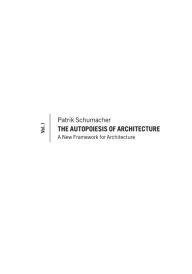
ISBN: 9780470772980
Take a theoretical approach to architecture with The Autopoiesis of Architecture, which presents the topic as a discipline with its own unique logic. Architecture's conception of itself i… Mehr…
| BarnesandNoble.com new in stock. Versandkosten:zzgl. Versandkosten. Details... |

ISBN: 9780470772980
Take a theoretical approach to architecture with The Autopoiesis of Architecture, which presents the topic as a discipline with its own unique logic. Architecture's conception of itself i… Mehr…
| BarnesandNoble.com new in stock. Versandkosten:zzgl. Versandkosten. Details... |

2011, ISBN: 9780470772980
Paperback, All pages and cover are intact. Possible slightly loose binding, minor highlighting and marginalia, cocked spine or torn dust jacket. Maybe an ex-library copy and not include t… Mehr…
| alibris.co.uk |

2011, ISBN: 0470772980
[EAN: 9780470772980], Gebraucht, guter Zustand, [PU: Wiley], Buy with confidence! Book is in good condition with minor wear to the pages, binding, and minor marks within, Books
| AbeBooks.de Books Unplugged, Amherst, NY, U.S.A. [74050220] [Rating: 5 (von 5)] NOT NEW BOOK. Versandkosten: EUR 45.80 Details... |

The Autopoiesis of Architecture, Volume I: A New Framework for Architecture: A New Framework for Architecture, Volume 1 Schumacher - Taschenbuch
2011, ISBN: 0470772980
[EAN: 9780470772980], [SC: 6.0], [PU: Wiley], ungebraucht, evtl minimalste Standspuren, Books
| ZVAB.com |


The Autopoiesis of Architecture, Volume I: A New Framework for Architecture Patrik Schumacher Author - neues Buch
ISBN: 9780470772980
Take a theoretical approach to architecture with The Autopoiesis of Architecture, which presents the topic as a discipline with its own unique logic. Architecture's conception of itself i… Mehr…

ISBN: 9780470772980
Take a theoretical approach to architecture with The Autopoiesis of Architecture, which presents the topic as a discipline with its own unique logic. Architecture's conception of itself i… Mehr…
2011
ISBN: 9780470772980
Paperback, All pages and cover are intact. Possible slightly loose binding, minor highlighting and marginalia, cocked spine or torn dust jacket. Maybe an ex-library copy and not include t… Mehr…
2011, ISBN: 0470772980
[EAN: 9780470772980], Gebraucht, guter Zustand, [PU: Wiley], Buy with confidence! Book is in good condition with minor wear to the pages, binding, and minor marks within, Books
The Autopoiesis of Architecture, Volume I: A New Framework for Architecture: A New Framework for Architecture, Volume 1 Schumacher - Taschenbuch
2011, ISBN: 0470772980
[EAN: 9780470772980], [SC: 6.0], [PU: Wiley], ungebraucht, evtl minimalste Standspuren, Books
Bibliographische Daten des bestpassenden Buches
| Autor: | |
| Titel: | |
| ISBN-Nummer: |
Detailangaben zum Buch - The Autopoiesis of Architecture, Volume I: A New Framework for Architecture Patrik Schumacher Author
EAN (ISBN-13): 9780470772980
ISBN (ISBN-10): 0470772980
Gebundene Ausgabe
Taschenbuch
Erscheinungsjahr: 2010
Herausgeber: Wiley Core >1 >T
478 Seiten
Gewicht: 1,078 kg
Sprache: eng/Englisch
Buch in der Datenbank seit 2007-02-08T12:28:14+01:00 (Berlin)
Detailseite zuletzt geändert am 2024-04-14T23:16:48+02:00 (Berlin)
ISBN/EAN: 9780470772980
ISBN - alternative Schreibweisen:
0-470-77298-0, 978-0-470-77298-0
Alternative Schreibweisen und verwandte Suchbegriffe:
Autor des Buches: schumacher patrik, are schumacher
Titel des Buches: new architecture, schumacher, volume, framework, autopoiesi, the autopoiesis architecture
Daten vom Verlag:
Autor/in: Patrik Schumacher
Titel: The Autopoiesis of Architecture - A New Framework for Architecture, Volume 1
Verlag: Wiley; John Wiley & Sons
480 Seiten
Erscheinungsjahr: 2010-12-03
Gewicht: 1,072 kg
Sprache: Englisch
51,90 € (DE)
Not available (reason unspecified)
172mm x 220mm x 32mm
BC; Hardcover, Softcover / Kunst/Architektur; Architektur; Architecture; Architektur; Bauwerk; Allg. Architektur; BB
Preface. 0 Introduction: Architecture as Autopoietic System. 0.1 Architecture as a System of Communications. 0.2 A Unified Theory of Architecture. 0.3 Functional vs Causal Explanations. 0.4 The Quest for Comprehensiveness. 0.5 The Premises Imported from Social Systems Theory. 0.6 Architecture's Place within Society. 1 Architectural Theory. 1.1 The Unity of Architecture. 1.1.1 Architectural System-formation and Self-regulation. 1.2 The Evolution of Architecture. 1.2.1 Architectural Theory as Mechanism of Selection. 1.3 The Necessity of Theory. 1.3.1 The Function of Architectural Theory. 1.3.2 Types of Theories. 1.3.3 The Necessity to Reflect Architecture's Societal raison d'etre. 1.3.4 Super-theories. 1.3.5 The Theory of Architectural Autopoiesis as Domain-specific Super-theory. 1.3.6 From Deconstruction to the Programme of Critical Theory. 2 The Historical Emergence of Architecture. 2.1 The Emergence of Architecture as Self-referential System. 2.1.1 Inside-descriptions vs Outside-descriptions. 2.1.2 Function Systems. 2.1.3 The Historical Crystallization of Architecture. 2.2 Foundation and Refoundation of Architecture. 2.2.1 Autonomization: The Origin of the Discipline in the Italian Renaissance. 2.2.2 The Refoundation of the Discipline as Modern Architecture. 2.2.3 The Exclusive Competency and Universal Scope of Modern Architecture. 2.2.4 The Liberation from Traditional Formal Constraints. 2.2.5 The Switch from Edifice to Space. 2.3 Avant-garde vs Mainstream. 2.3.1 A Prerequisite for Evolution. 2.3.2 The Autonomy of the Avant-garde. 2.3.3 Communications between Avant-garde and Mainstream. 2.3.4 The Reciprocal Dependency between Avant-garde and Mainstream. 2.3.5 The Time Structure of the Avant-garde Process: Cumulative vs Revolutionary Periods. 2.3.6 Concrete Exemplars vs Abstract Principles. 2.3.7 Revolution and Philosophy. 2.3.8 Latent Utopias vs the Utopian Ambitions of the Historical Avant-garde. 2.3.9 Retroactive Manifestos. 2.4 Architectural Research. 2.4.1 Architectural Research as Avant-garde Design Research. 2.4.2 Architecture Schools as Laboratories. 2.5 The Necessity of Demarcation. 2.5.1 The Differentiation of Art and Architecture. 2.5.2 The Differentiation of Science and Architecture. 2.5.3 The Differentiation of Architecture and Engineering. 2.5.4 The Rationality of Demarcation. 2.5.5 The Specificity of Architecture within the Design Disciplines. 3 Architecture as Autopoietic System - Operations, Structures and Processes. 3.1 Architectural Autopoiesis within Functionally Differentiated Society. 3.1.1 Niklas Luhmann's Theory of Modern Society. 3.1.2 Third Order Observation. 3.1.3 Codes and Media. 3.1.4 The Concept of Social Autopoiesis. 3.2 The Autonomy of Architecture. 3.2.1 Openness through Closure. 3.2.2 Irritations. 3.2.3 Communication Structures. 3.3 The Elemental Operation of Architecture. 3.3.1 Design Decisions. 3.3.2 Network-dependency of Elemental Operations. 3.3.3 Design Decisions and External Demands. 3.4 The Lead-distinction within Architecture and the Design Disciplines. 3.4.1 The Primacy of Distinctions. 3.4.2 Form vs Function as the Lead-distinction within the Design Disciplines. 3.4.3 The Double Reference of the Design Disciplines. 3.5 The Codification of Architecture. 3.5.1 Binary Codes. 3.5.2 Utility and Beauty as the Double Code of Architecture. 3.5.3 Polycontexturality. 3.5.4 The Unique Double Code of Architecture as Demarcation Device. 3.5.5 The Double Code of Architecture and the Triple Code of Avant-garde Architecture. 3.5.6 Discursive Oscillation: Coping with an Expanding Universe of Possibility. 3.5.7 Abstraction and Openness. 3.6 Architectural Styles. 3.6.1 The Concept of Style(s). 3.6.2 The Rationality of Style(s). 3.6.3 Styles as the Necessary Programmes of Architecture. 3.6.4 Styles Regulate Form and Function. 3.6.5 Reluctant Styles. 3.6.6 The Inescapability of the Formal A Priori. 3.6.7 The Double Contingency of Style Formation. 3.6.8 Stylistic Awareness as Second Order Observation. 3.6.9 Progress as Progression of Styles. 3.7 Styles as Research Programmes. 3.7.1 The Creativity of Styles/Research Programmes. 3.7.2 The Tenacity of Styles/Research Programmes. 3.7.3 The Structure of Styles/Research Programmes: Autonomy, Hard Core, Heuristics. 3.7.4 The Great Historical Styles: Hard Core and Heuristics. 3.7.5 Problem Domain and Solution Space as Sources of Stylistic Innovation. 3.7.6 Paradigmatic Mainline and Speculative Extrapolation. 3.7.7 Progressive vs Degenerate Styles/Research Programmes. 3.7.8 Methodological Tolerance. 3.8 The Rationality of Aesthetic Values. 3.8.1 The Historical Transformation of Aesthetic Values. 3.8.2 Aesthetic Values and the Code of Beauty. 3.8.3 The Mystery of Beauty. 3.8.4 Formal A Priori, Idiom and Aesthetic Values. 3.8.5 The Necessity of Aesthetic Revolutions. 3.8.6 Aesthetic Values: Designers vs Users. 3.9 The Double-nexus of Architectural Communications: Themes vs Projects. 3.9.1 The Unity of the Difference between Themes and Projects. 3.9.2 The Difference between Themes and Projects. 3.9.3 The Interaction between Themes and Projects. 4 The Medium of Architecture. 4.1 Medium and Form. 4.1.1 Symbolically Generalized Media of Communication. 4.1.2 The Medium as Revealing and Concealing. 4.1.3 The Medium as Universe of Possibilities. 4.1.4 Medium and Manner. 4.1.5 The Standard Medium of Architecture. 4.1.6 Recursive Self-reference. 4.2 The Medium and the Time Structure of the Design Process. 4.2.1 Differance: The Productive Vagueness of the Medium. 4.2.2 The Diagram. 4.2.3 Specious vs Point-like Time: The Time Structure of the Architectural Project. 5 The Societal Function of Architecture. 5.1 Architecture as Societal Function System. 5.1.1 Function vs Service. 5.1.2 Function Systems and the Functional Exigencies of Society. 5.1.3 Framing as Societal Function of Architecture. 5.1.4 The Definition of the Situation as Precondition of Social Interaction. 5.1.5 Framing Double Contingency. 5.1.6 Double Contingency Radicalized. 5.1.7 The relationship between Art and Architecture in terms of their Societal Function. 5.2 Innovation as Crucial Aspect of Architecture's Societal Function. 5.2.1 The Burden and Risk of Permanent Innovation. 5.2.2 The Innovative Capacity of Architecture's Operations and Structures. 5.2.3 Variation, Redundancy and Adaptive Pertinence. 5.3 Strategies and Techniques of Innovation. 5.3.1 The Power of Abstraction. 5.3.2 The history of Architectural Innovations. 5.3.3 Conceptual Manoeuvres. 5.4 Key Innovations: Place, Space, Field. 5.4.1 The Emergence of Architectural Space. 5.4.2 The Hegemony of Architectural Space. 5.4.3 The Transcendence of Architectural Space. 5.4.4 From Space to Field. Concluding Remarks. Appendix 1: ComparativeMatrix of Societal Function Systems. Appendix 2: Theses 1-24. References. Index. Picture Credits.Weitere, andere Bücher, die diesem Buch sehr ähnlich sein könnten:
Neuestes ähnliches Buch:
9781119990499 The Autopoiesis of Architecture, Volume I (Patrik Schumacher)
- 9781119990499 The Autopoiesis of Architecture, Volume I (Patrik Schumacher)
- 9780470772997 The Autopoiesis of Architecture Volume I by Patrik Schumacher Hardcover | Indigo Chapters (PS Schumacher)
- [(The Autopoiesis of Architecture: v. 1: A New Framework for Architecture)] [ By (author) Patrik S. Schumacher ] [February, 2011]
- The Autopoiesis of Architecture, Volume I (Patrik Schumacher)
< zum Archiv...



